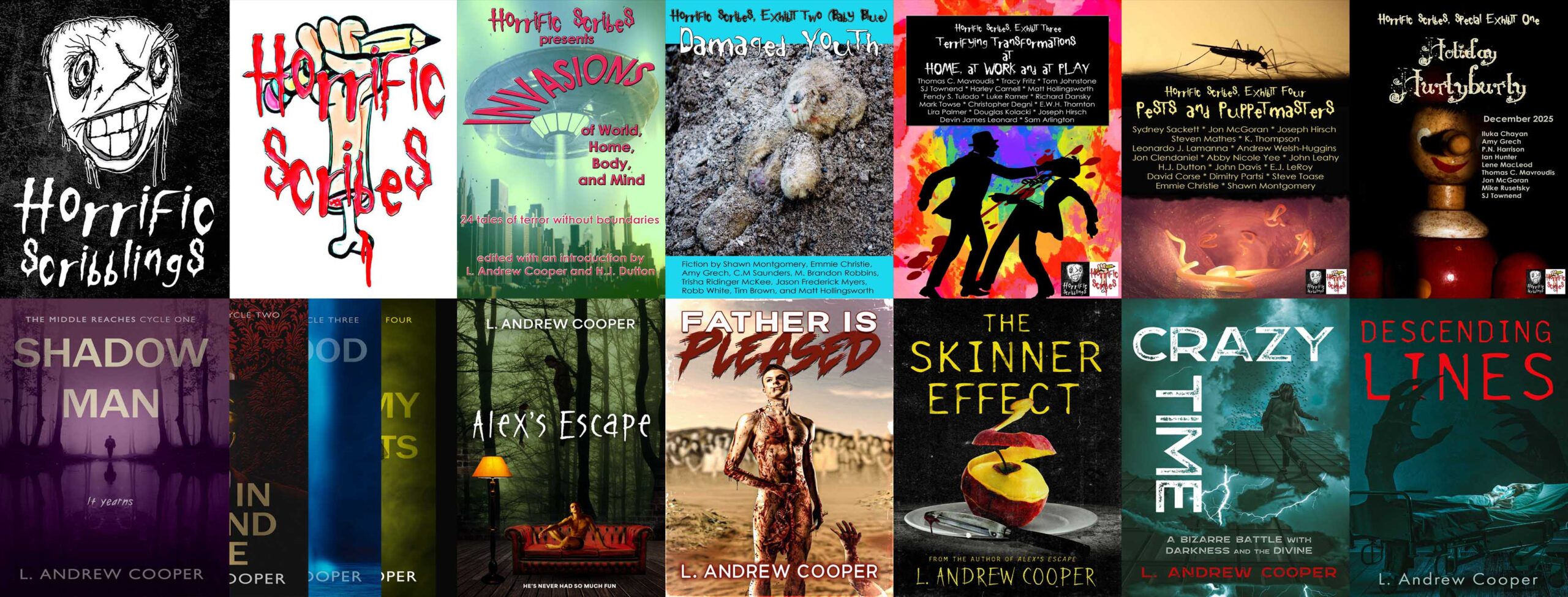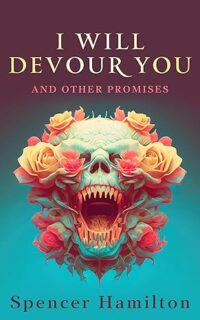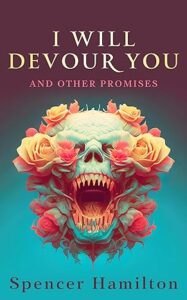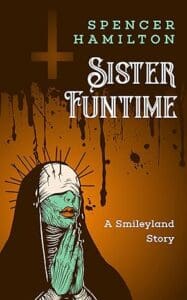Skilled and stylistically daring storyteller Spencer Hamilton talks about many striking dimensions of his eclectic new collection of horror tales.
I Will Devour You and Other Promises
Spencer Hamilton has returned with 13 brutal tales of horror, of succumbing to the darkness, of revenge and cruelty and monsters. A man wakes in his own grave… a little girl’s day at Smileyland turns into a nightmare… a grieving father faces the terror lurking beneath the ice of a frozen lake… the antichrist’s mother live-tweets her escape… a forest grows overnight in the Vatican… and a tumor whispers, I will devour you! Come on inside, but be warned—these stories devour.
With a foreword by Jeremy Megargee, author of Stained & Starless Places
“Hamilton doesn’t mess around, and he’s not afraid of taking chances.” —Michael R. Goodwin, author of Smolder
The Interview
1. Uncanny Devourers. A doppelganger in “This Goes Out to You,” trances involving automaton-like behavior in “Smile and Say Your Prayers,” submerged figures coming to the surface in “The Cold, The Grief,” creatures within trying to break free in both “The Tweeted Confession of Mariam Thornwood” and “I Will Devour You”—the first two directly evoke the tales of E.T.A. Hoffmann (1776 – 1822), on whose work Freud draws for his theory of “the uncanny,” a feeling of being familiar and unfamiliar at the same time that comes from “the return of the repressed,” an idea horror critics often use to describe what horror is really “about.” All these stories, and perhaps more in the collection, feature something I’d say invites a Freudian response, some dangerous (re)emergence that threatens to destroy the protagonist. Do you think the Freudian uncanny is a concept that applies well to your stories? Why or why not? What lies under the surface, what might be the repressed, in a tale such as “This Goes Out to You” or “I Will Devour You?” More generally, how important is psychology to your storytelling, and how do you develop your stories’ psychological dimensions?
SH: The psyche is a crucial aspect of my storytelling because I think horror as a genre is mostly an exploration of the mind when applied with abnormal pressure. We as an audience watch these characters make choices and respond to horrific circumstances, and part of the fun is wondering how we ourselves would behave in such a situation. In that same way, horror is great at holding a mirror up to society and then warping the reflection—or, worse still, proving that it’s not the mirror that’s warped, but the life we’ve accepted as the social norm.
More specifically, “This Goes Out to You”—as well as “The Tweeted Confession of Mariam Thornwood”—was my exploration of society’s mass perception: people are celebrating a “happy ending,” but our protagonist knows it’s a lie and can do nothing about it. “I Will Devour You” was more a play on body horror, which is especially horrifying for people like me with disabilities who feel their body betraying their mind.
But to answer your last question—the honest truth is that I develop my stories’ psychological dimensions in perhaps the most Freudian way possible: I let my subconscious drive that particular train. I can more consciously shape whatever came out later in the editing process.
2. Promising Experiments. Your story notes mention podcasts and other practical inspirations for some of your more stylistically experimental stories, but uses of second-person narration in “You Are Beneath It All” and “Evidence Locker VHS Tape #6,” Twitter-based narration in “The Tweeted Confessions of Mariam Thornwood,” repeated phrases to represent troubled consciousness throughout the volume, and other techniques are nonetheless bold. What draws you to techniques outside of narrative norms? What are the risks and payoffs? Stylistically, what’s the riskiest story in the book and why? Which risk paid off the most and why? What experiments are you most and least likely to repeat? Why?
SH: I think short stories are one of the very best mediums for experimentation. It’s how I got started as a writer—each story was a new opportunity to explore some idea. Because of that, I actually believe my first collection, Kitchen Sink, is far more experimental than I Will Devour You and Other Promises. Part of that was me finding my identity and voice as a writer, but I’ve always been drawn to writers that play with form. One of my absolute favorite writers of short stories is Paul Tremblay, in large part because he takes so many bold swings with various narrative devices, and I think it pays off in spades. I think why I love that so much is that a good use of epistolary or metafiction—even in much longer works like House of Leaves or Cloud Atlas—is like a good magic trick: you’re drawn in, it feels real, like this fictional world is lived-in … and you believe.
For this new collection, I’d say its opener, “This Goes Out to You,” is the riskiest of the bunch. Sure, later in the book there’s second-person narration, there’s found-footage, there’s a whole Twitter thread; but the opening story is a quick shot that ends with an unsettling amount of “WTF did I just read?” ambiguity. We as a culture put so much importance on a story’s ending, so something like the ending of “This Goes Out to You” tends to be a “love it or hate it” risk. But I think it’s “The Tweeted Confession of Mariam Thornwood” that lands best with readers, because as a culture we’re all so chronically online, and telling a story through social media allowed me to use shorthand, or internet speak, and worry far less about the actual craft of the writing. (Though, after Elon Musk burned it to the ground, I probably won’t use that specific trick again.) I also think second-person narrative voice, like in “You Are Beneath It All” and “Evidence Locker VHS Tape #6, is super underrated, so I hope to use that more in the future.
3. A Universe of Grief. Your story notes also point out that a figure known as “the angler” or “the grief angler” appears in three stories, a nice bit of world-building that adds cohesion to the collection. The angler is central to “The Cold, The Grief,” the story that so far is sticking with me most. Among other things, it seems to be about suicide, though the language is careful. Do you mean to tread into this territory, and if so, why do you handle it the way you do? Feelings of loss, guilt, and an impending doom that might be deserved run throughout these stories—why are they so prominent? What makes them so central to your vision of horror?
SH: I love learning that “The Cold, the Grief” stuck with you the most. I worked incredibly hard on that story, especially on putting Dusty through the five stages of grief—yet even then, after working through all of that, I think death was still a thing of relief for him. I definitely meant to put Dusty through such heavy emotions from the beginning—I know it may seem like a monster story, but it’s not, it’s about grief, about Dusty’s grief monster, if you will. I’d been introduced to grief horror by Laurel Hightower’s Crossroads and the conceit of that subgenre really resonated with me. Horror, to me, is a safe (ish) space to explore many taboo yet real-to-life subjects, a place where we can be made to look directly at an ugly thing but with the veil of the make-believe—almost a kind of therapy. This idea became most clear to me in the writing of “The Overnight Forest” (but we’ll get to that).
4. (Dis)connection. I like the bleak stuff. Another favorite is “The Stars, They’re Laughing,” a tale of soul-crushing alienation with a cosmic backdrop that I think qualifies it as cosmic horror, though it’s a very different sort of cosmic horror from that in “I Will Devour You,” which is more traditionally Lovecraftian. What draws you to the cosmic, and what is the status of the stars—the heavens—in your universe? Is alienation a universal condition, or is everyone connected but perhaps you/me? Is the creation and abuse of outcasts, like in “The Stars, They’re Laughing,” inevitable? Why or why not?
SH: I also like the bleak stuff—I love the general hope that Stephen King weaves in his stories, but I get an especial thrill reading his bleaker stories like Pet Sematary and Revival. Cosmic horror, I think necessarily so, feels extra bleak because the idea that we humans are actually insignificant in the grand scheme of things goes against just about every one of our instincts. Many religions are built on the idea that we humans are the reason for all of existence, which, to me, is wildly arrogant. That’s what I always loved about Lovecraft’s best stories: the real horror is that existence is far beyond the scope of even our wildest imaginations.
The idea that we all die alone is often too horrible to look at head-on, but I think all of us can relate to this feeling in different ways. “The Stars, They’re Laughing,” for example, deals with the loneliness that comes from bullying. There were times in my childhood when certain groups, for whatever reason, made me feel like I didn’t belong, like I was completely alone, which ironically is something I think we’re all familiar with. That story comes from that place—from a very specific bullying experience of mine—but is upgraded with the idea I first heard from Neil deGrasse Tyson that we’re all made of stardust. A lovely, romantic concept, but then that invites the horror: What if you find out that you are so different from everyone else, so alone, so other, that this universe doesn’t recognize you even down to a subatomic level? It’s kind of the inverse of Lovecraft’s usual: what if you are the thing that defies description?
5. Religion and Other Promises. Though your Story Notes mention you were not raised Catholic, several stories touch on Catholicism, “Smile and Say Your Prayers” and “The Overnight Forest” centrally. Why is Catholicism such an interest? Catholicism has been an interest of Gothic/horror writers since the horror genre’s literary beginning. Your ghostly nun in “Smile and Say Your Prayers,” which is part of your Smileyland storyverse, reminded me not just of the recent nun-craze in cinema (The Nun and sequel, 2018 and 2023, Immaculate, 2024, The First Omen, 2024) but also of the “bleeding nun” tangent in Matthew Lewis’s The Monk (1796). How does your nun relate to her historical and contemporary sisters, and why do you think your nun, Sister Funtime, has become such a large figure in your work? As for “The Overnight Forest” (you do a great job conjuring the Vatican, btw), it’s a passionate story—why are you so passionate about the Church’s broken promises?
SH: Thank you so much for the compliment about my depiction of the Vatican—that was perhaps the most difficult writing experience of my life, partly because I was so concerned with trying to accurately depict a place I’d never been that was so in love with its own secrecy.
I was raised in the Mormon church, and I’m sure I’ll put that in future stories. When I turned 18 and left my parents’ church, I left all religion. And since part of horror, for me, is facing traumas and facing the taboo, I always knew I wanted to write religious horror. Catholicism has a long-storied tradition in horror for many reasons, but I think the biggest is simply the Gothic aesthetic that it provides, and the familiar shorthand it gives storytellers. Nuns especially provide a striking figure in the genre—Immaculate and The First Omen are two of my favorite films this year. Sister Funtime is fun for me because I have a lot of compassion for Mary, the young woman under the habit who just wants to protect the children, so I’ve enjoyed giving her her own kind of redemption.
But also, my use of Catholicism in my stories is largely reactionary. I’m frankly sick of all the movies where priests and Christianity itself are portrayed as the heroes, the good force that fights evil, because it feels like a whole lot of propaganda. Over and over again, decade after decade, members of clergy—Catholic priests most famously, probably because of the sheer wealth and power of the Vatican—are the predators, not the saviors. I see the tides turning in storytelling—see it in movies like Spotlight or, in horror, Saint Maud—and that gives me hope. To answer your last question: I attack this problem in “The Overnight Forest” with such passion because of questions like this; because, to me, it shouldn’t be a question of why I’m passionate about it, but why so many people in this world would rather turn a blind eye.
6. Nature and Payback. Speaking of “The Overnight Forest,” the titular forest is an intervention in the Catholic Church’s business as usual—a possible judgment—and in “The Ones Who Watch,” owls might be part of what’s referred to at one point as “the judgment of hell.” Trees and birds—nature sits in judgment. Why does nature take on these roles in these stories? What do you see as the role of “nature” in your fiction more generally? Does a relationship, or lack of a relationship, with nature have to do with a person’s closeness to, or deservingness of, “hell?”
SH: Ooh, I love that connection that you’ve drawn here. On my part it wasn’t intentional, but if we’re speaking on a Freudian level here, maybe I’m drawn to nature in a similar way that I’m drawn to the cosmic. Human civilization, in many ways, acts like a parasite in nature. We’re killing this planet, ya know? I don’t consciously insert environmentalism into my writing, but it does make a kind of sense that nature should be the entity that doles out our judgment, yes?
7. Other Devourers. Judgment and payback motivate more than the non-human side of nature. “Momma’s Monster,” perhaps the most extreme story, follows a woman who hunts men she thinks of as monsters. “You Are Beneath It All” presents another fairly extreme take on a devouring vengeance. Your Story Notes mention a growing interest in the extreme. Do you expect your extremes to continue going hand in hand with representations of vengeance? Does the suggestion of just desserts mitigate the violence, make the gore more palatable? Why or why not?
SH: My “education” in the horror genre is ongoing. I’ve been delving more into extreme horror and splatterpunk recently. They’re far from my favorite thing in horror, but I think every subgenre has its own merits, so I do think I’ll dip my toe in more. A favorite theme of mine is that humans are the real monsters, and extreme horror is a great sandbox for variations on that theme. But to your point, I do think that giving a character a reason for the violence makes it more palatable. Empathy reaches out even to characters that have given up hope for their own redemption. And on a more philosophical level, I think some monsters benefit from the status quo, so there’s a certain level of justice in the victim refusing to play nice and instead going and settling their own score. Storytelling, in this and other ways, can be a form of radical protest.
8. Class and Other Promises. Two stories in the collection highlight issues related to socioeconomic class. In “The Ones Who Watch,” the main character sees most city inhabitants as members of a lesser species while he is “untouchable because of his bank account.” In “Evidence Locker VHS Tape #6,” the perspective character (“you”) is from a richer area than the other characters, which causes conflict. Why is there room in horror stories for reflections on class? Does a consistent vision or critique lie behind both stories? In both stories, how does socioeconomic standing relate to character psychology?
SH: To continue from my last answer, I believe storytelling and art in general to be intrinsically political. The best genres in speculative fiction for this kind of exploration, in my opinion, are science fiction and horror. There’s a bit of a renaissance of socioeconomic commentary in horror right now—the Purge movies, The Menu, Ready Or Not, Blink Twice, the list goes on and on. I think that’s just a response to the times we live in, where so many people are feeling disillusioned and betrayed by the system. Horror has always been the most current and responsive in this way. In the specific stories you mention, I don’t believe I intended a specific critique, and the main focus in both stories is elsewhere—but there’s that Freudian train again, driving my own inner thoughts on class and the haves and have-nots, tinting the lens with which I see the world and reflecting it in my writing.
In “The Ones Who Watch,” it lends Charles Acker a perceived bulletproof armor that is ultimately his undoing (judged so by nature, as you noted earlier); but in “Evidence Locker VHS Tape #6,” it makes Wills the outcast among kids he just wants to be accepted by—really, they’re all victims of the respective classes they were born into, the poor Witch’s Port kids and Wills, the privileged Queen’s Shore kid. The ending to “Evidence Locker VHS Tape #6” is bleak, but that was intentional, as I meant it as a reflection of certain harsh realities inherent in this kind of capitalist system.
9. (De)regulation. The story “Stomp” presents an almost ritualistic battle between sounds and rhythms, between the beeping of an alarm clock, a force aligned with domestic abuse, and the stomping of feet, which might be a march toward liberation. How does a clock become a force of violence and oppression? How does this battle of sounds and rhythms become a horror story? Trying to avoid spoilers, I’ll say that “Out of the Shadows, Into the Sun” also stages a kind of ritualistic struggle with oppression, combining the collection’s most overt treatment of queer characters with issues related to colonialism. What makes queer oppression and colonial oppression a good mix for horror? Why doesn’t the collection portray overtly queer characters and concerns more often, and do you intend to address more queer characters and concerns in future work?
SH: I don’t mean to harp on how all art is political, but … all art is political.
In “Stomp,” the oppressor is the patriarchy, specifically the labor of running a household that is expected of women, especially in older generations; this being expressed through the motif of blaring alarm clocks was my own invention—as a musician and former music teacher, I love using recurring motifs and sounds to show a character’s experience—but the rest was handled beautifully by that story’s co-author, Amy Rochester.
“Out of the Shadows, Into the Sun” was my first overtly queer story I sold to a publisher after I came out publicly. I had already written it as colonial oppression, which, just like many things we’ve talked about here, is a great source of commentary for horror, but after I came out, the publisher invited me to expand the story. Writing the queer oppression was, in a way, liberating for me, a sort of coming-out of its own. Much of my writing deals with queer themes—my novel The Fear most heavily by far, but also in Welcome to Smileyland and Sister Funtime, as well as my upcoming novel (another Witch’s Port story!) Winter’s Bite and the queer horror anthology I had the honor of editing, There’s More of Us Than You Know—and I plan to continue that for the rest of my career. But many of the stories in this collection and in Kitchen Sink were written in a time when I was still closeted.
10. Access! How can readers learn more about you and your works (please provide any links you want to share)?
SH: Find me on Instagram! That’s where I’m most active, @spencer.hamilton.books. You can also keep up with my releases on Goodreads and Amazon, as well as my website spencerhamiltonbooks.com (which is under maintenance as of this writing but will be back soon) where you can sign up for my newsletter.
Thanks so much for these insightful questions and for your time, Andrew! What you do here is deeply appreciated, by me and indie horror authors everywhere.
About the Author
Spencer Hamilton is a queer horror author living in Philadelphia. His works include the short story collections Kitchen Sink and I Will Devour You and Other Promises, as well as his novel The Fear and novellas Welcome to Smileyland and Sister Funtime. His short fiction has appeared in anthologies from publishers such as DarkLit Press, Mad Axe Media, Pyke Publishing, Dark Pine Publishing, and more. He is the editor of the queer horror anthology There’s More of Us Than You Know.







